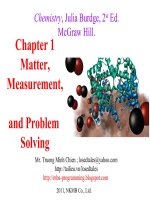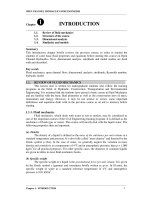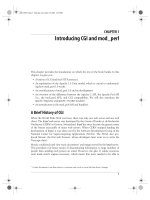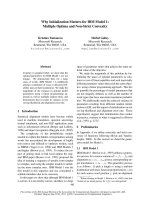English for marketing
Bạn đang xem bản rút gọn của tài liệu. Xem và tải ngay bản đầy đủ của tài liệu tại đây (309.4 KB, 76 trang )
Chapter 1
Key terms
Definition
Customer needs
States of felt deprivation
The form human needs take as they are
shaped by culture and individual personality
Human wants that are backed by buying
power
Some combination of products, services,
information, or experiences offered to a
market to satify a need or want
The customer's evaluation of the difference
between all the benefits and all the costs of
marketing offer relative to those of
competing offers
The extent to which a products's perceived
performance matches a buyer's
expectitations
The act of obtaining a desired object from
someone by offering something in return
The set of all actual arid potential buyers of
a products or service
The process by which companies engage
customers, build strong customer
relationsips, and create customer value in
order in order to capture value from
customer value in order to capture value
from customers in return.
the idea that consumers will favor products
that are available and highly affordable;
therefore, the organization should focus on
improving production and distribution
efficiency.
The idea that consumers will favor products
that offer the most quality, performance, and
features; therefore, the organization should
devote its energy to making continuous
product improvements
The idea that consumers will not buy enough
of the firm's products unless the firm
undertakes a large-scale selling and
promotion effort.
A philosophy in which achieving
organizational goals depends on knowing
the needs and wants of target markets and
delivering the desired satisfactions better
Wants
Demand
Market offerings
Marketing
Channel Basics
Marketing Concepts and Process
Customer perceived value
Customer satisfaction
Exchange
Market
Concepts
Markeitng
Production concept
Product concept
Selling concept
Marketing concept
Societal marketing concept
Customer relationship management
Customer lifetime value
Customer equity
Marketing planning
Marketing implenmentation
Marketing mix
Marketing control
Marketing audit
Marketing
Landscape
Societal marketing
Consumerism
Sustainable marketing
than competitors do.
The idea that a company's marketing
decisions should consider consumers' wants,
the company's requirements, consumers'
long-run interests, and society's long-run
interests.
The overall process of building and
maintaining profitable customer
relationships by delivering superior
customer value and satisfaction.
The value of the entire stream of purchases a
customer makes over a lifetime of
patronage.
The total combined customer lifetime values
of all of the company's customers
The central instrument for directing and
coordinating the marketing effort.
Turning marketing strategies and plans into
marketing actions to accomplish strategic
marketing objectives.
The set of tactical marketing tools product,
price, place, and promotion that the firm
blends to produce the response it wants in
the target market
The process of measuring and evaluating the
results of marketing strategies and plans and
taking corrective action to ensure that
objectives are achieved
A comprehensive, systematic, independent,
and periodic examination of a company's
environment, objectives, strategies, and
activities to determine problem areas and
opportunities and to recommend a plan of
action to improve the company's marketing
performance
A company should make marketing
decisions by considering consumers' wants,
the company's requirements, consumers'
long-run interests, and society's long-run
interests.
An organized movement of citizens and
government agencies designed to improve
the rights and power of buyers in relation to
sellers.
Socially and environmentally responsible
Digital marketing
Customer-engagement marketing
Consumer-generated marketing
Question
True/False
marketing that meets the present needs of
consumers and businesses while also
preserving or enhancing the ability of future
generations r to meet their needs.
involves using digital marketing tools such
as websites, social media, mobile ads and
apps, online video, email, blogs, and other
digital platforms to engage consumers
anywhere, anytime via their computers,
smartphones, tablets, internet ready TVs,
and other digital devices.
Making the brand a meaningful part of
consumers' conversations and lives by
fostering direct and continuous customer
involvement in shaping brand conversations,
experiences, and community
Brand exchanges created by consumers
themselves - both invited and uninvited - by
which consumers are playing an increasing
role in shaping their own brand experiences
and those of other consumers
Answers
Price is total expenses to get the
benefits from using products.
FALSE
Many sellers make the mistake of
paying more attention to the specific
product they offer than to the benefits
and experiences produced by these
products. These sellers suffer from
selling concept.
TRUE
In Customer-generated marketing,
consumers themselves are playing a
bigger role in shaping their own brand
experiences and those of others
TRUE
Customer asset is the total combined
customer lifetime values of all of the
company's customers
FALSE
Customer-perceived value is
determined by a customer's personal
assessment of the benefits and costs of a
market offering relative to those of
competing offers
TRUE
Match
Wants are needs that are shaped by
personal preferences, culture, or
religion.
TRUE
Marketing concept is the idea that a
company’s marketing decisions should
consider consumer’s wants, the
company’s requirements, consumers’
long-run interests, and society’s longrun interests.
FALSE
Marketing consists of actions taken to
create, maintain, and grow desirable
profitable ......with target audiences
involving a product, service, idea, or
other object.
relationships
...... buy again and tell others about their
good experiences. Dissatisfied
customers often switch to competitors
and disparage the product to others.
Customer value and ............... are key
building blocks for developing and
managing customer relationships.
The marketing manager’s aim is to
engage, keep, and grow target
customers
Satisfied customers
Customer satisfaction
Customer value
by creating, delivering, and
communicating superior ...............
Explainations
Marketing Implementation
Marketing mix
Production concept
Marketing control
Turning marketing strategies and plans into
marketing actions to accomplish strategic
marketing objectives
The set of tactical marketing tools—
product, price, place, and promotion— that
the firm blends to produce the response it
wants in the target market
The idea that consumers will favor products
that offer the most quality, performance, and
features; therefore, the organization should
devote its energy to making continuous
product improvements.
The process of measuring and evaluating the
results of marketing strategies and plans and
Customer equity
Marketing Audit
Custumer relationship management
Marketing Strategy
Markeitng concept
Product concept
MCQ
The societal marketing concept seeks to
establish a balance between consumer
short-run wants and consumer
According to the production concept,
consumers will favor products that are
________ and ________.
A firm that uses the selling concept
takes a(n) ________ approach.
The art and science of choosing target
markets and building profitable
relationships with them is called
________.
Which of the following involves
adapting a firm to take advantage of
opportunities in its constantly changing
environment?
taking corrective action to ensure that
objectives are achieved
The total combined customer lifetime values
of all of the company’s customers
A comprehensive, systematic, independent,
and periodic examination of a company’s
environment, objectives, strategies, and
activities to determine problem areas and
opportunities and to recommend a plan of
action to improve the company’s marketing
performance
The overall process of building and
maintaining profitable customer
relationships by delivering superior
customer value and satisfaction
The marketing logic by which the company
hopes to create customer value and achieve
profitable customer relationships
A philosophy in which achieving
organizational goals depends on knowing
the needs and wants of target markets and
delivering the desired satisfactions better
than competitors do
The idea that consumers will favor products
that offer the most quality, performance, and
features; therefore, the organization should
devote its energy to making continuous
product improvements.
long-run welfare
available; affordable
inside-out
marketing management
strategic planning
Consumer insight
Marketing information system (MIS)
Marketing research
observational reasearch
Ethnographic research
Survey research.
Experimental research
Focus group interviewing
Online marketing research
Online focus groups
Sample
is a term that implies a depth of
understanding of consumers; more than that,
it implies sensible use of this understanding
to help consumers
fulfil their needs.
is really an information bank where data
relevant to the marketing decision makers.
is a systematic process of searching,
collecting, analysing and interpreting
information to helps marketing manager
making effective marketing decision, to
solving a marketing problem that they are
facing to.
Gathering primary data by observing
relevent people, actions and situation
A form of observational research that
involves sending trained observers to watch
and interact with consumers in their "natural
environments".
Gathering primary data by asking people
questions about their knowledge, attitudes,
preferences, and buying behavior
Gathering primary data by selecting matched
groups of subjects, giving them different
treatments, controlling related factors, and
checking for differences in group responses
Personal interviewing that involves inviting
small groups of people to gather for a few
hours with a trained interviewer to talk about
a product, service, or organization. The
interviewer "focuses" the group discussion
on important issues.
Collecting primary data through internet and
mobile surveys, online focus groups,
consumer tracking, experiments, and online
panels and brand communities
Gathering a small group of people online
with a trained moderator to chat about a
product, service, or organization and gain
qualitative insights about consumer attitudes
and behavior.
A segment of the population selected for
marketing research to represent the
population as a whole. Questionnaire. A
research instrument consisting of a series of
questions for the purpose of gathering
Sampling unit.
Population
Coding
Hypothesis
Data analysis
Codebook.
Mean
Mode
Standard deviation.
Median
Question
The real value of marketing information
lies in how it is used—in the customer
insights that it provides.
The customer service department keeps
records of customer satisfaction or
service problems. It is a source of
marketing research information.
Starbucks wants to know how
customers would react to a new
breakfast menu item, they should use
marketing intelligence.
The marketing world is filled to the
brim with information from
innumerable sources.
Nowadays, marketers don’t need more
information; they need better
information from respondents. It can be
thought of as a kind of written interview.
A typically thought of as an object that has
been sampled from a statistical population.
Any complete group of people or entities
sharing some common set of characteristics
the group from which a sample is taken.
The process whereby raw data are
transformed into standardized form suitable
for machine processing and analysis
An unproven proposition that can be
supported or refused by market research.
Statistical and/or qualitative consideration of
data gathered by research.
The document used in data processing and
analysis that tells the location of different
data items in a data file.
An average computed by summing the
values of several observations and dividing
by the number of observations
An average representing the most frequently
observed value or attribute
A measure of dispersion around the mean
An average representing the value of the
"middle" case in a rank-ordered set of
observations.
Answers
TRUE
TRUE
FALSE
TRUE
FALSE
information. And they need to make
better use of the information they
already have.
To create value for customers and build
meaningful relationships with them,
marketers must first gain fresh,
deep ............into what customers need
and want.
The ............research is to describe
things, such as the market potential for
a product or the attitudes of consumers
who buy the product.
A ......... is a research instrument
consisting of a series of questions for
the purpose of gathering information
from respondents.
must be conducted to have good
information for making marketing
decision
....is the method in which the researcher
selects the easiest population members
from which to obtain information.
To test hypotheses about cause-andeffect relationships, the research can be
classified as a Answer
Causal
research
Normally, the hardest step in the
research process is defining the problem
and research (b)
Online Marketing Reasearch
Observational research
Closed-ended Questions
Mean
Focus group interviewing
insights
Descriptive
Questionnaire
Marketing research
Convenience sample
Causal
Objectives
Collecting primary data through internet and
mobile surveys, online focus groups,
consumer tracking, experiments, and online
panels and brand communities
Gathering primary data by observing
relevant people, actions, and situations
provide answers that are easier to interpret
and analyze.
An average computed by summing the
values of several observations and dividing
by the number of observations
Personal interviewing that involves inviting
small groups of people to gather for a few
hours with a trained interviewer to talk about
a product, service, or organization.
Simple random sample
Methodology
Findings
Sample
Data analysis
Which of the following is NOT a
potential source for marketing
intelligence?
This involves the process and methods
used to gather information, analyze it,
and report findings related to marketing
of goods and services.
Which is not the method of primary
data collection?
Three basic or main components of
marketing information system are
_____________
What is one of the benefits of a
marketing information system?
.Every member of the population has a
known and equal chance of selection.
explains why the research design is
appropriate for achieving the research
objectives and answering the research
questions.
It is where the results of the study are
reported in detailprovide answers that are
easier to interpret and analyze.
.A segment of the population selected for
marketing research to represent the
population as a wholeIt is where the results
of the study are reported in detailprovide
answers that are easier to interpret and
analyze.
tatistical and/or qualitative consideration of
data gathered by research.An average
computed by summing the values of several
observations and dividing by the number of
observations
collecting primary data
Markeitng Research
Publication
internal data, marketing research, marketing
intelligence
It helps you know more about your
competitors' actions.
It helps you understand what motivates
people to buy a product.
It provides you with information about your
customers' buying habits and wants.
________ is the systematic collection Marketing intelligence
and analysis of publicly available
information about consumers,
competitors, and developments in the
marketing environment.
_______ data refers to the data which is
Secondary
readily available.
The first step in Marketing Research is
to ____________.
Identify and Define the Problem
Your colleague is confused about using
the marketing research process, as he
knows that something is wrong but is
not sure of the specific causes to
defining the problem and research objectives
investigate. He seems to be having
problems with ________, which is often
the hardest step to take.
Which of the following is not a reason
deciding how many staff to hire to
businesses use marketing research?
manufacture the goods.
Chapter 3
Marketing Environment
Key terms
Definition
Form an important link in the company's
Suppliers
overall customer value delivery network
Firms that help the company to promote, sell
Marketing intermediaries
and distribute its goods to final buyers
A company or individual that competes for
Competitor
trade with one's own
Any groups that has an actual or potential
Publics
interest in or impact on an organization's
ability to achieve its objectives
The actors close to the company that affect
its ability to serve its customers - the
The micro-environment
company, suppliers, marketing
intermediearies, customer markets,
competitors and publics
This group influences the company's ability
to obtain funds. Banks, investment analysts,
Financial publics
and stockholders are the major financial
publics
This group carries news, features, editorial
opinions, and other content. It includes
Media publics
television stations, newspapers, magazine,
and blogs and other social media
Those with the ability to affect the company
or its products/ services through legislation
Goverment publics
and laws that could regulate or restrict
product manufacturing or marketing efforts
Citizen-action publics
Organized groups with special interests who
would question the actions of a company,
potentially placing it in the public spotlight
Internal publics
General publics
Local publics
Consumer market
Business market
Reseller market
Goverment market
International market
Physical distribution firms
Marketing service agency
Reseller
Financial intermediaries
The macro-environment:
The demographic environmeat:
This group includes workers, managers,
volunteers, and the board of directors
A commpany needs to be cocerned about the
general public's attitude toward its profucts
and activites
This group includes local community
residents and organizations
A market that consist of individuals and
households that buy goods and services for
personal consumption
A market that buys goods and for further
processing or use in their production
processes.
A type of market that buys goods and
services to resell at a profit.
A market that consists of government
agencies that buy goods and services to
produce public services or transfer the goods
and services to others who need them
A market that consists of all kinds of buyers
in other countries, including consumers,
producers, resellers, and governments.
These are the companies that help to
warehouse (store and protect goods) and
move goods from their points of origin to
their destinations.
Advertising' promotional agencies, media
agencies, marketing research firms are
companies that supply the help that is
needed to promote products by targeting
reaching/communicating the best prospects
for products and services.
This group includes wholesalers and
retailers. Some reseller firms are powerful
and demanding, so much so that it can be
difficult for companies to work with them.
This group includes banks, insurance
companies, and credit-related agencies that
supply the financing needed for the conduct
of business, and insurance against risks
connected with the conduct of business.
Broader forces that affect the actors in the
microenvironment.
Human population characteristics that
surround a firm or nation and greatly affect
The natural environment:
The technological environment:
The economic environment:
Generation 1X
Millennials (Generation Y)
Generation Z
Generational marketing:
Environmental sustainability
Socially responsible behavior
Cause-related marketing
Core belief
markets: size, density, location, age, gender,
race, occupation, and other statistics.
Forces that involve the physical environment
and the natural resources that are needed as
inputs by marketers or that are affected
marketing activities.
forces that create new technologies, creating
new product and market opportunities.
Forces that consist of economic factors that
affec consumer purchasing power and
spendin patterns. Economic factors can have
dramatic effect on consumer spendinn
buying behavior.
People who were born between 1965 and
1979.
People who were born between 1981 and
1995.
People who were born between 1997 and
2012.
Creating separate products and marketing
programs for each generation.
Developing strategies and practices that
create a world economy that the planet can
support indefinitely.
Companies seek out ways to protect the
long-run interests of their consumers and the
environment.
A mutually beneficial collaboration between
a corporation and a nonprofit designed to
promote the former's sales and the latter's
cause.
Basic beliefs about ourselves, other people,
and the world we live in.
Answer
Question
Choose the concept for the following
definition:
The internal environment is conformed
by departments or areas such as finance,
human resources, accounting,
the company
purchasing, and the top management,
which share the responsibility for
understanding customer needs and
creating customer value.
Financial publics are ________
banks
Which factor that does NOT affect the
Microenvironment?
The publics does not include
_________
As the director of marketing for Little
Hanoi Hospital, you must conduct a
market research into the marketing
environment to help create a five-year
marketing plan for the hospital. Which
of the following environmental trends
should you consider to be the most
important?
Firms that provide the resources needed
by the company to produce goods or
offer services are ___________.
Choose the concept to the following
definition:
It consists of the actors and forces
outside marketing that affect marketing
management's ability to build and
maintain successful relationships with
target customers.
More magazine is a publication
designed to appeal to women aged 40
and over. Demand for such magazines
is an example of how changing
__________ characteristics impact the
marketing environment.
Which of the following statements is
true?
The economic environment
the supplier
The number of people in the geographic area
who are 65 years or older will increase by 23
percent during the next five years.
the supplier
Marketing environment
demographic
Demography is the study of human
population in terms of size, density, location,
age, gender, occupation and other statistics.
Local newspaper readership has
declined significantly in recent years.
Not only are traditional newspapers
losing subscribers, they are also losing
advertisers. To combat these trends, social, resulting from changing consumer
many newspaper publishers now offer preferences for information delivered online
online versions of their printed
newspapers. This is most likely a
response to which environmental
factor?
Question
Answer
Any group that has an actual or
potential interest in or impact on an
organization's ability to achieve its
objectives is called___
The macro environment are the larger
societal forces that affect the micro
environment - demographic, economic,
ecological, technological,___, and
cultural forces.
____ is the study of the human
population in terms of size, density,
locations, gender, race, occupation and
other statistics.
Individuals and households who buy
goods or services for personal
consumption are_____
____ help to warehouse (store and
protect goods) and move goods from
their points of origin to their
destinations.
____ consists of the actors and forces
outside marketing that affect marketing
management's ability to build and
maintain successful relationships with
target customers
In terms of its effect on marketers, the
increased in petrol price, mostly
effected the ____ environment.
Larger societal forces such as
demographic, economic, natural,
political, and others that affect
marketing management's decisions are
part of _____
Firms that help the company to
promote, sell and distribute its goods to
final buyers are _____
____ buys goods and services for
further processing or use in their
production processes.
publics
political
demography
consumer market
physical distribution
the marketing environment
economic
the macro-environment
marketing intermediaries
business market
Question
Answer
Changes in the price or quality of raw Macro
materials – for example wood, or metals
– will affect the marketing mix.
You must differentiate your brand from
your competitors.
Good relations between a supplier and a
company mean that goods are always
delivered on time.
Legislation in European countries is
restricting the right to smoke in public
places.
During the FIFA World Cup, more
snack food is consumed in front of the
TV set.
Employing the right people and keeping
them motivated is essential.
High unemployment in a region reduces
spending on leisure activities.
Positive reports in the national press
about a brand.
The staff for the telephone hotline of an
internet bank are trained to be polite
and friendly.
The Internet has opened up new
distribution and marketing channels.
Chapter 4
Key terms
Consumer market
Consumer buyer behavior
Motive
Culture
Micro
Micro
Macro
Macro
Micro
Macro
Micro
Micro
Macro
Buyer behavior
Definition
The consumer market includes. both
individual and household buyers who buy
products or services for their own
consumption.
Consumer buyer behavior refers to the
actions taken (both online and offline) by
final consumers before they buy goods and
services for their personal consumption.
For example, they will consider whether or
not to buy a product, or where to buy it.
When a need is sufficiently roused, it
becomes a motive, which will direct thie
person to seek satisfaction of the need.
Motives can include product motives
(different attributes of the product that
induce the consumer to buy it) and
patronage motive (reasons to buy the goods
from a particular shop).
The set of basic values, perceptions, wants,
Subculture
Social class
Life stages
Marketing stimuli
Perception
Word-of-mouth influence
Opinion leader
Low-involvement products
High-involvement product
and behaviors learned by a member of
society from family and other important
institutions.
A group of people with shared value systems
based on common life experiences and
situations.
Relatively permanent and ordered divisions
in a society whose members- share similar
values, interests and behaviors.
The stages of the family life cycle, through
which families might pass as they mature
over time. Life-stage changes usually result
from life-changing events such as marriage,
having children, purchasing a home,
divorce, children going to college, changes
in personal income, moving out of the
house, and retirement.
Marketing stimuli may include an additional
innovative feature of an existing product, a
low price of a product penetrating a new
market, a discount or gift provided with the
purchase of a product, or even an
outstanding atmosphere of the store.
Consumer perception is their awareness,
impression and opinions about products or
brands. For example, when a retail clothing
store has displayed clothes in crowded racks
using low quality plastic hangers, customers
get a perception that it is a low-quality
brand.
The impact of the personal words and
recommendations of trusted friends, family,
associates, and other consumers on buying
behavior.
Opinion leaders often have a strong social
status and a significant number of followers
in their social networks.
Their recommendations an opinions are
listened to when consumers make important
decisions: Opinions leaders should be
suitable for brand or product characteristics.
Consumers do not need to think too much
before purchasing the product and may
simply select a familiar brand out of habit.
Consumers need extensive thought and
consider a lot of variables before making a
purchase decision.
This buying behavior occurs when
consumers are highly involved in the
Complex buying behavior
purchase of products which are expensive,
risky or purchased infrequently.
This buying behavior occurs when
consumers are involved in the purchase
Dissonance-reducing buying behavior. products which are expensive, infrequently
bought but see little difference among
brands.
This buying behavior occurs when
consumers have low involvement with the
Habitual buying behavior
purchase and there are little significant
perceived differences among brands.
Consumer buying bchavior in situations
characterized by
Variety-seeking buying behaviour
low consumer involvement but significant
perceived brand differences.
This is the first step of the buyer decision
Need recognition
process when the buyer I recognizes a
problem or need.
The consumer is motivated to-search for
Information search
more information related to the need.
The consumer uses the information to
Evaluation of alternative
evaluate alternative brands in the choice set.
The buyer's decision about which brand to
Purchase decision.
purchase
Consumers take further action after purchase
Postpurchase behavior.
based on their satisfaction or dissatisfaction.
Unexpected events may happen and change
the purchase intention. For example, the
economy might take a turn for the worse, a
Situational factors
close competitor might drop its price, or a
friend might report being disappointed in
your preferred car.
The mental process through which an
Adoption process.
individual passes from first hearing about an
innovation to final adoption.
The consumer become aware of the new
Awareness
product but lacks information about it.
The consumer seeks information about the
Interest
new product,.
Trial
The consumer tries out the innovative
Coffering, but there is not yet any further
purchase conitment.
Evaluation
Adoption
Innovators
Early adopters
Early mainstream
Late mainstream
Lagging adopters
Buying center
Users
Influencers
Buyers
Deciders
Gatekeepers
Problem recognition
Gencral need description
Product specification
Supplier search
The consumer considers whether trying the
new product makes sense.
The consumer decides to make full and
regular use of the new product.
Adopters who try new ideas at some risks.
Opinion Icaders in their communities and
adopt new ideas early but carefully.
Adopt new ideas before the average person
Adopt an innovation only after a majority of
people have tried it
Suspicious of changes and adopt the
innovation only when it has become
something of a tradition itself
All the individuals and units that play a role
in the purchase decision-making process.
Members of the buying organization who
will actually use the purchased product or
service.
People in an organization's buying center
who affect the buying decision; they often
help define specifications and also provide
information for evaluating alternatives.
People in an organization's buying center
who make an actual purchase.
People in an organization's buying center
who have formal or informal power to select
or approve the final suppliers.
People in an organization's buying center
who control the flow of information to
others.
The first stage of the business buying
process in which someone in the company
recognizes a problem or need that can be
met by acquiring a good or a service
The stage in the business buying process in
which a buyer describes the general
characteristics and quantity of a needed
item.
The stage of the business buying process in
which the buying organization decides on
and specifies the best technical product
characteristics for needed item.
The stage of the business buying process in
which the buyer tries to find the best
Proposal solicitation
Supplier selecton
Order-routine specification
Performance review
Chapter 5
Key terms
Segmentation
Targeting
Differentiation
Positioning
Revenue
profit
Brand image
Publicity
Awareness
Price consciousness
vendors.
The stage of the business buying process in
which the buyer invites qualified suppliers
to submit proposals.
The stage of the business buying process in
which the buyer reviews proposals and
selects a supplier or suppliers.
The stage of the business buying process in
which the buyer writes the final order with
the chosen supplier(s), listing the technical
specifications, quantity needed, expected
time of delivery, return policies, and
warranties.
The stage of the business buying process in
which the buyer assesses the performance of
the supplier and decides to continue, modify,
or drop the arrangement.
STP
Definition
the process of dividing a general market into
segments of buyers with distinct needs,
characteristics, or behaviors that might
require separate marketing strategies or
mixes
the company's effort to evaluate each market
sedment's attractiveness and then, select one
or more segments to enter into
involves differentiating the firm's market
offering to create superior customer value
consists of arranging for a market offering to
occupy a clear, distinctive, and desirable
place ralative to competing products in the
minds of target customers
Income generated from business operation
the difference between the amount earned
and the amount spenr
is the customer perception of a brand
the activity of making certain that someone
or something attracts a lot of interest or
attention for many people
knowledge about something or
understanding of a situation or subjects
knowing how much things cost and avoiding
buying expensive things
airlines that offer low fares but eliminate all
non-essential services suggest
No-frill airlines
complimentary food in flights entertainment
systems and seating arrangements
they are typically described as chipper nofrills or budget airlines. The flights provided
Low-cost carriers
are generally short haul with the majority of
the bookings being made online
divides the market into different
geographical units such as nations, regions,
Geographic segmentation
territories, cities, neighborhood and
population density
The dividing of an overall market into
homogeneous groups on the basis of
population location. it is the oldest
segmentation approach
The dividing of an overall market into a
Demographic segmentation: age,
homogeneous groups based on
gender, nationality, ethnic origin
characteristics such as age sex and income
level. it is the most frequently used approach
divides buyers into different segments based
Psychographic segmentation
on social class lifestyles values and
psychological/personality traits
The dividing of an overall market into
homogeneous groups through the use of
behavioral profiles developed from analyzes
of the activities, opinions, interests, and
lifestyles of consumers
divides the market into segments based on
Behavioral segmentation
their knowledge, attitudes, uses or responses
concerning a product
The dividing of an overall market into
homogeneous groups on the basis of benefits
the consumer exposed to derive from a
product or service and the related usage rates
of a product or service
comprises of three levels. heavy users are
small in number but could account for a high
Usage rate
percentage of consumption. Medium and
light users.
requires finding major benefits people look
Benefit segmentation: product
for in a product class, the kinds of people
performance, knowledge/ awareness of
who look for each benefits and brands that
a product
deliver each benefit
Multiple segmentation
is popular since marketers rarely use only









